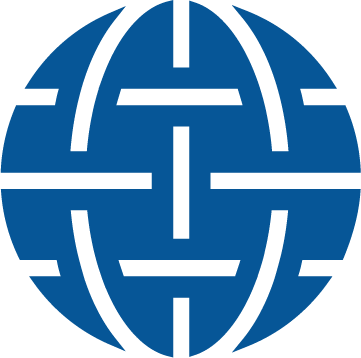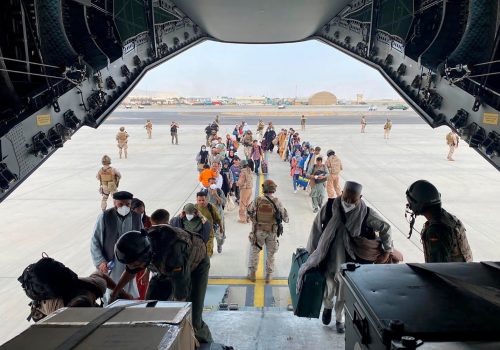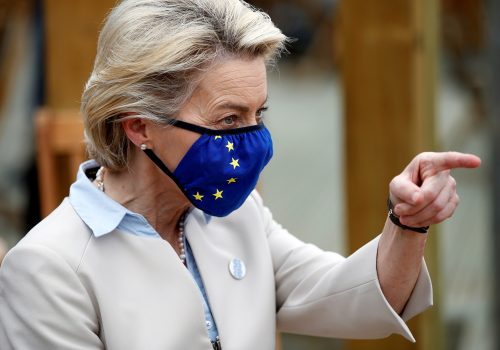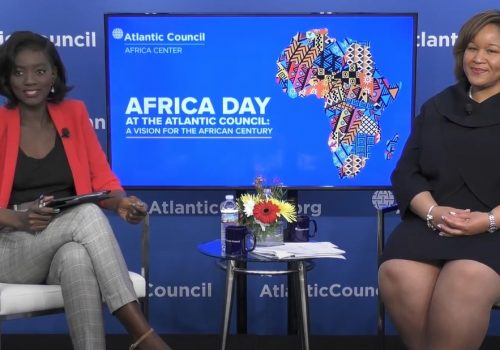A cable from Mali: How to bring Bamako back from the brink

Date:
From:
To:
Cable from Mali:
Classification:
8/27/2021
Olivier-Rémy Bel and Petr Tůma
European and American policymakers
Last chance to bring the Sahel back from the brink
Unclassified
This summer, fellows with the Atlantic Council’s Europe Center conducted a study trip to Mali as part of an ongoing project exploring European involvement in the Sahel region. They cabled their thoughts back to the home office for the first edition of the Atlantic Council’s “Cable from.”
Summary: While our interlocutors in Mali were split, focusing either on areas showing progress or those that are deteriorating, they did agree on one thing: The country is at an inflection point. Against the backdrop of two coups, interethnic and terrorist violence moving south toward Bamako, and France shifting its posture in the Sahel, this could be the last chance to stabilize Mali. Doing so will require fostering greater Malian ownership of the political, security, and development processes, both by understanding local dynamics and by asking for greater accountability from national authorities. It will also require improving coordination among Europeans—now contributing to stabilization efforts in ever greater numbers—and thereby creating a “European art of the coalition.”
Sitting along the banks of the Niger River, which was starting to swell as the rainy season picked up, we listened to our host, a seasoned European diplomat, describe the complexities of his job. As the patches of water hyacinths drifted away, carried by the swirls and eddies of the current, the situation seemed as murky as the waters.
With its billion-dollar stabilization effort, counterterrorism operations, and attempts at state-building, Mali invites a comparison with Afghanistan. Substitute the Americans for the French and the towering heights of the Pamirs with the endless expanses of the Sahara, and this is Europe’s Afghanistan.
While lessons can be drawn from Afghanistan—particularly in terms of empowering local partners, shifting towards a lighter footprint without generating a collapse, sustaining public support for intervention, and managing a coalition—Mali is a country that must be understood in its own right. For instance, terrorists in the Sahel do not have the equipment and experience of the Taliban, there are no neighboring countries providing shelter and support, and the ethnic and political dynamics are unique.
A former French colony, the butterfly-shaped country stretches along the Niger River, which flows from the greener south to the more arid north. Its banks are home to many ethnic groups, from the Bambara majority in the south to the Bozo fishermen, Fulani herders, and Dogon farmers in the center, and the Tuaregs in the north.
In 2012, as the crumbling state faced Tuareg separatists and jihadists moving south, it turned to France for help. The French-run Operation Serval stopped the advance before being transformed into a regional counterterrorism operation called Barkhane. The international community, especially Europeans, has been present in greater numbers, notably through the United Nations Multidimensional Integrated Stabilization Mission in Mali (MINUSMA) and the European Union Training Mission Mali (EUTM). Regional actors have attempted to organize themselves by creating the G5 Sahel and its joint force, while the Economic Community of West African States (ECOWAS) is also stepping up, playing an important political role in the aftermath of the 2020 and 2021 coups.
Today, the jihadist threat mostly emanates from the Islamic State in the Greater Sahara (ISGS) and the Jama’at Nasr al-Islam wal Muslimin (JNIM), an Al-Qaeda franchise. While the situation in northern Mali, the Tuareg heartland, is now more stable, violence is moving south.
Clashes with the ISGS mostly take place in the tri-border region where Mali, Niger, and Burkina Faso meet. But international efforts in the area—particularly the G5 Sahel joint force and Task Force Takuba, a newly stood-up European special forces operation—have so far been able to contain and degrade the jihadists. Central Mali, however, is seeing a larger JNIM presence, which feeds off a cycle of interethnic violence mostly between the Dogon and Fulani communities.
This movement south of both interethnic and terrorist violence is spilling over into neighboring countries, notably Burkina Faso, and could threaten the coastal states, such as Côte d’Ivoire.
1. Is this Mali’s last chance?
As we moved from interview to interview, critical questions were on everyone’s mind: Are the international community and Malian authorities actually making progress? Or have we already lost the war? Could Mali go the way of Afghanistan?
It’s difficult to find consensus on even that basic assessment.
The Malian Armed Forces (FAMa) are better trained and equipped than they were a few years ago. The sort of deadly attacks seen in 2018-2019, when entire military camps were overrun by terrorists, are repelled. Present in a greater part of the country’s territory, Malian forces conduct more complex operations, including alongside French troops, and are beginning to develop air power by relying on Brazilian-made Super Tucano planes. Multiple senior terrorist leaders have been killed, and the north enjoys an uneasy peace—or at least a form of tacit stability.
At the same time, terrorist attacks are occurring closer to the capital than ever before. The central part of the country is continuing its downward spiral of interethnic violence, catching in its wake neighboring Burkina Faso and possibly Guinea and Cote d’Ivoire, along Mali’s southern border. At the political level, the 2015 Algiers Agreement, aimed at restoring peace in Mali through a process of political reconciliation and decentralization, is still not fully implemented. Moreover, the country has experienced two coups within one year, signaling severe institutional fragility.
In Bamako, as well as in European capitals where we also conducted interviews, frustration is palpable among Europeans. Everybody agrees that the only solution for stabilizing Mali is a political one—though with an important military component due to terrorists’ advances—and it can only be Malian. But are the country’s elites ready and eager enough to move boldly and implement the necessary political and administrative reforms?
This may be the last chance to do so for three reasons:
a. After the coup last summer, which ousted President Ibrahim Boubacar Keïta following contested elections, army colonels led by Assimi Goïta seized power. The resulting civilian transitional government grew increasingly autonomous. After the government kicked out two key figures in the August 2020 coup without properly coordinating with Goïta, the colonels could feel power slipping from their hands. They conducted a second coup in May 2021, ousting transitional President Bah N’daw. If the ongoing process of political transition isn’t successful, there is serious potential for further destabilization. The two coups have, to some extent, served as a wake-up call for Europeans.
b. Interethnic violence and terrorism are moving south toward the demographic and economic heart of the country. While the Bambara majority and elites may have been reluctant to invest politically and militarily in the north—where Bamako traditionally had only limited control and applied a divide-and-rule approach—this more immediate threat is becoming increasingly existential and might spur the government toward more responsible behavior. The government should convince people of its reliability and gain their trust. Otherwise, Malians won’t be ready to defend it, and the country risks falling into a tailspin as happened in Afghanistan immediately after the withdrawal of foreign support. Europe is able to train enough Malian soldiers, as the coalition managed to do in Afghanistan. The problem lies in the meaningful deployment of these troops when the government is not working properly or is perceived as such.
c. France is adopting a new approach in the Sahel. President Emmanuel Macron recently announced the end of Operation Barkhane in its current form, with a drawdown from 5,100 troops to as low as around 2,500 in 2022. While this could be compared to the US withdrawal from Afghanistan, the transformation of the French presence is less about numbers and more about doing things differently—a shift toward a support-and-accompany model. This is a move in the right direction, but will it be enough to empower Malian forces?
We also spoke with Malian civil-society and religious leaders, who stressed the need for Europeans to engage more on the local level rather than just with Bamako and to be more responsive to local contexts. That’s something that is occasionally difficult even for Malian officials themselves, who often come from the south, which can lead to mutual mistrust. Development projects that have been implemented outside Bamako and other urban areas have had only limited impact and sustainability, as they were missing a sense of ownership and trust from the local population. Local civic representatives often pointed to the communication deficit of Malian officials and the Malian army in rural areas where people may be afraid of their operations and plans, which creates yet another obstacle for state-building efforts.
As the international community talks about “the return of the Malian state”—and we heard a lot about “PSDG,” the acronym standing for security, development, and governance hubs—the big question is: Which state is returning? In some areas, the Malian state was never fully present to begin with. In others, sending civil servants from the south might not always be the best solution. What matters is the ability to provide concrete public services.
2. Creating a “European art of the coalition”
Bamako is an interesting place to meet Europeans. Today, the Sahel hosts the largest deployment of European military forces worldwide, with around eight thousand personnel. It has also been a key focus of diplomatic efforts and international development assistance; Europe alone has spent nearly ten billion dollars on the region since 2014.
Paris led the response to the Malian government’s 2012 call for assistance and is still an indispensable player, owing to its deep historical ties with Mali and relatively large military and diplomatic presence in the country. Yet European troops have been accompanying their French counterparts from the outset. Operation Serval was enabled by British and Spanish airlift capabilities. Sweden took a leading role early on through the United Nations peacekeeping mission (MINUSMA) in Mali.
The European military presence in Mali has grown in recent years. Countries are sending ever larger contingents (German troops number almost one thousand, for example) or contributing in new formats—such as Czech special forces accompanying Malians in combat as part of counterterrorism-focused Task Force Takuba. Some, mostly in southern Europe, fear potential migration and other spillover effects if the “neighbors of their neighbors” were to be destabilized. For others, it’s about deepening the relationship with France or demonstrating their commitment to European solidarity.
In fact, Europeans and other players have been entering the Malian theater to such an extent that it has created a traffic jam. Coordination among the various military forces—the FAMa, the EUTM, Barkhane, MINUSMA, the G5 Sahel Joint Force—is a complex challenge. However, the introduction of Instance de coordination militaire au Mali, a platform for regular meetings among all force commanders, appears to have helped.
On the development side, coordination among Europeans, Americans, and other major multilateral donors needs improvement. The same challenge already exists among European countries, since each has its own national agenda, timeline, and procedures. Representatives of several local NGOs complained to us that European development projects often overlap, periodically focusing on the same sectors, when their help may really be needed elsewhere. In this crowded landscape, the EU delegation seems to have emerged as an important place for Europeans to synchronize their actions. Still, it is far from what is needed, as it lacks a mandate strong enough to overcome EU nations’ bilateral interests.
More broadly, this is all an exercise in creating a “European art of the coalition.” So far, European forces have mostly deployed and worked together in coalitions that required a US backbone, as in Afghanistan. When they have deployed alone, such as in the Democratic Republic of Congo or Chad, they have rarely had to operate in such a difficult and complex environment, or handle so much civilian-military coordination, as they have in Mali.
This applies particularly to the relationship between France and other European nations. While the French have a more extensive historical background in Mali and are clearly the leading European actor there, Paris will have to adapt its leadership to account for the growing influence of other European players. It is not in the position to play the same role the United States played in Afghanistan, and must instead strive to find its own way to compel Europeans to work together.
The Sahel is often described as a laboratory for strategic autonomy, where Europeans learn how to work together and hone their political, diplomatic and military instruments. This kind of European coalition-building may be one of the most potent experiments.
3. Learning to speak the language of power
Sometimes Europeans are shy about translating their preeminent presence and investment into political power. The COVID-19 crisis has shown them to be less proactive—or less unashamedly self-promoting—than, say, the Chinese. For instance, Chinese officials did well in convincing Malians that China was responsible for most of the COVID-related help that Mali received from abroad, even though that was not the case. Russia is also making some advances in Mali, notably agitating pro-Russian demonstrations, exploring yet another opportunity to make life more difficult for the West.
If Europe wants Malians to truly own the stabilization process, it must avoid creating a dependency or establishing a presence there that only benefits the elite. This was indeed one of the problems in Afghanistan, leading to the abysmal failure of its government and army. As soon as the United States departed, people were unprepared to fight for a government they didn’t trust.
If the EU and its member states are to provide such substantial assistance to Mali, they should be able to attach more conditions to the provision of those resources. One oft-cited example is the Malian army’s lack of a digital human-resources management system, which means it cannot know the precise number or whereabouts of its soldiers. Given that half of the FAMa have been trained by the EUTM, Europe should be in a position to more forcefully ask for this type of reform. The Malian government seems less responsive to European requests than governments in other areas of major European engagement abroad, such as Iraq.
The European diplomats we met in Mali viewed this hazard as one of the major risks that could undermine the success of European engagement there. It is also understood, at least on paper, by Brussels: April’s EU Integrated Strategy in the Sahel emphasizes the concept of “mutual accountability,” while the European Council in May opened the door to sanctions on Malian politicians and military leaders.
These lessons learned in Mali are part of a broader ongoing EU adaptation to a more challenging strategic environment. From the ambitions of a “geopolitical Commission” to chief diplomat Josep Borrell’s chaotic Moscow trip to the EU’s tough retaliation against Belarusian President Alyaksandr Lukashenka’s hijacking of a Ryanair flight, Europe is not only searching for its place in a more dangerous world but also learning to respond to such a world. Far from simply learning to speak the language of power, it is experimenting with wielding it.
Lessons for the future
Mali and Afghanistan are indeed very different theaters for intervening forces.
There isn’t a single organization in Mali as popular as the Taliban, uniting opposition to the government. Rebel groups are often fighting one another; even the Tuaregs in the north can’t aspire to the level of prominence enjoyed by the Taliban in Afghanistan.
Still, that doesn’t preclude the risk that the outcome may one day appear similar if the proper lessons aren’t learned. The fall of Kabul is a major development for Europe, which must be in a position to react to a crisis even when the United States is unwilling to intervene.
After years of talking about strategic autonomy, Europe must get serious about it. This is what’s at stake in Mali.
Further reading
Image: United Nations police patrol Menaka Region in northeast Mali. (Flickr/MINUSMA/Gema Cortes)




